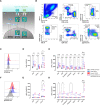Altered increase in STAT1 expression and phosphorylation in severe COVID-19
- PMID: 34676541
- PMCID: PMC8646801
- DOI: 10.1002/eji.202149575
Altered increase in STAT1 expression and phosphorylation in severe COVID-19
Abstract
The interferon pathway, a key antiviral defense mechanism, is being considered as a therapeutic target in COVID-19. Both, substitution of interferon and JAK/STAT inhibition to limit cytokine storms have been proposed. However, little is known about possible abnormalities in STAT signaling in immune cells during SARS-CoV-2 infection. We investigated downstream targets of interferon signaling, including STAT1, STAT2, pSTAT1 and 2, and IRF1, 7 and 9 by flow cytometry in 30 patients with COVID-19, 17 with mild, and 13 with severe infection. We report upregulation of STAT1 and IRF9 in mild and severe COVID-19 cases, which correlated with the IFN-signature assessed by Siglec-1 (CD169) expression on peripheral monocytes. Interestingly, Siglec-1 and STAT1 in CD14+ monocytes and plasmablasts showed lower expression among severe cases compared to mild cases. Contrary to the baseline STAT1 expression, the phosphorylation of STAT1 was enhanced in severe COVID-19 cases, indicating a dysbalanced JAK/STAT signaling that fails to induce transcription of interferon stimulated response elements (ISRE). This abnormality persisted after IFN-α and IFN-γ stimulation of PBMCs from patients with severe COVID-19. Data suggest impaired STAT1 transcriptional upregulation among severely infected patients may represent a potential predictive biomarker and would allow stratification of patients for certain interferon-pathway targeted treatments.
Keywords: COVID-19; IRF9; STAT1; Type I interferon; pSTAT1.
© 2021 The Authors. European Journal of Immunology published by Wiley-VCH GmbH.
Conflict of interest statement
The authors declare no conflict of interest.
Figures




Similar articles
-
Elevated STAT1 expression but not phosphorylation in lupus B cells correlates with disease activity and increased plasmablast susceptibility.Rheumatology (Oxford). 2020 Nov 1;59(11):3435-3442. doi: 10.1093/rheumatology/keaa187. Rheumatology (Oxford). 2020. PMID: 32357246
-
Elevated unphosphorylated STAT1 and IRF9 in T and B cells of primary sjögren's syndrome: Novel biomarkers for disease activity and subsets.J Autoimmun. 2024 Jul;147:103243. doi: 10.1016/j.jaut.2024.103243. Epub 2024 May 24. J Autoimmun. 2024. PMID: 38788537
-
Intracellular expression of IRF9 Stat fusion protein overcomes the defective Jak-Stat signaling and inhibits HCV RNA replication.Virol J. 2010 Oct 12;7:265. doi: 10.1186/1743-422X-7-265. Virol J. 2010. PMID: 20939906 Free PMC article.
-
A Positive Feedback Amplifier Circuit That Regulates Interferon (IFN)-Stimulated Gene Expression and Controls Type I and Type II IFN Responses.Front Immunol. 2018 May 28;9:1135. doi: 10.3389/fimmu.2018.01135. eCollection 2018. Front Immunol. 2018. PMID: 29892288 Free PMC article. Review.
-
The unique role of STAT2 in constitutive and IFN-induced transcription and antiviral responses.Cytokine Growth Factor Rev. 2016 Jun;29:71-81. doi: 10.1016/j.cytogfr.2016.02.010. Epub 2016 Mar 18. Cytokine Growth Factor Rev. 2016. PMID: 27053489 Review.
Cited by
-
COVID-19Base v3: Update of the knowledgebase for drugs and biomedical entities linked to COVID-19.Front Public Health. 2023 Mar 6;11:1125917. doi: 10.3389/fpubh.2023.1125917. eCollection 2023. Front Public Health. 2023. PMID: 36950105 Free PMC article.
-
Transcriptomic responses of cumulus granulosa cells to SARS-CoV-2 infection during controlled ovarian stimulation.Apoptosis. 2024 Jun;29(5-6):649-662. doi: 10.1007/s10495-024-01942-9. Epub 2024 Feb 26. Apoptosis. 2024. PMID: 38409352
-
Bioinformatics analyses of gene expression profile to identify pathogenic mechanisms for COVID-19 infection and cutaneous lupus erythematosus.Front Immunol. 2023 Oct 31;14:1268912. doi: 10.3389/fimmu.2023.1268912. eCollection 2023. Front Immunol. 2023. PMID: 38022551 Free PMC article.
-
STAT1 and Its Crucial Role in the Control of Viral Infections.Int J Mol Sci. 2022 Apr 7;23(8):4095. doi: 10.3390/ijms23084095. Int J Mol Sci. 2022. PMID: 35456913 Free PMC article. Review.
-
Phosphorylation of interferon regulatory factor 9 (IRF9).Mol Biol Rep. 2023 Apr;50(4):3909-3917. doi: 10.1007/s11033-023-08253-3. Epub 2023 Jan 20. Mol Biol Rep. 2023. PMID: 36662450 Free PMC article.
References
-
- Platanias, L. C. , Mechanisms of type‐I‐ and type‐II‐interferon‐mediated signalling. Nat. Rev. Immunol. 2005. 5: 375–386. - PubMed
-
- Vivier, E. , Tomasello, E. , Baratin, M. , Walzer, T. and Ugolini, S. , Functions of natural killer cells. Nat. Immunol. 2008. 9: 503–510. - PubMed
-
- Bonjardim, C. A. , Interferons (IFNs) are key cytokines in both innate and adaptive antiviral immune responses–and viruses counteract IFN action. Microbes Infect. 2005. 7: 569–578. - PubMed
Publication types
MeSH terms
Substances
Grants and funding
LinkOut - more resources
Full Text Sources
Medical
Research Materials
Miscellaneous

